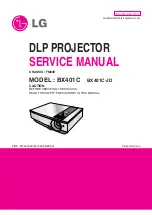
5. Continue retracting the lens.
a) If the bottom edge of the image comes into focus before the lens is completely retracted,
adjust the vertical boresight screw to direct or aim the lens mount up towards the top of
the screen to balance out the top and bottom edges.
b) If the top edge of the image is not in focus, adjust the vertical boresight screw to direct or
aim the lens mount toward the bottom of the screen.
6. When both sides appear equally blurry, adjust the horizontal and/or vertical offset to re-center
the image on the screen.
7. Repeat Steps 2 to 5 until the top and bottom of the screen are both focused.
8. Re-focus the center of the image.
The image should be focused at the center and on all sides.
9. Tighten the vertical hold screw to maintain the adjustments.
10. Check the boresight again.
Adjusting DMD convergence
A convergence problem can be identified when one or more projected colors (red, green, and blue)
appears misaligned when examined with a convergence test pattern.
The three colors should overlap to form pure white lines throughout the image and one or more poorly
converged individual colors may appear adjacent to some or all of the lines.
When adjusting the convergence, you are adjusting red and green to blue.
If you wear glasses with corrective lenses when performing this adjustment, ensure you are viewing the
test pattern on a straight angle through the optical axis of your glasses and not from a tilted or angled
perspective. This avoids a prismatic effect that can appear to shift convergence when viewing at an
angle.
Adjusting the image
CP2420-Xe and CP4420-Xe Installation and Setup Guide
43
020-103555-01 Rev. 1 (03-2022)
Copyright
©
2022 Christie Digital Systems USA, Inc. All rights reserved.








































